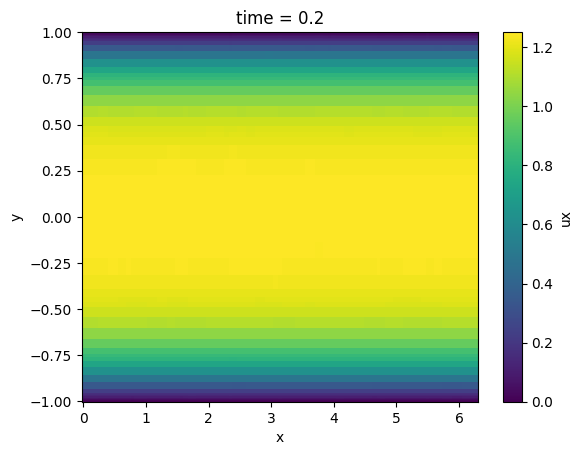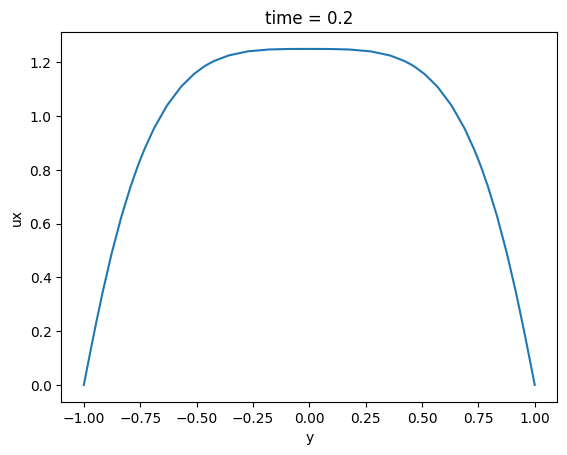Usage#
Pymech is a simple interface to read / to write Nek5000 and SIMSON specific data files to / from the Python world. With this capability you could:
make publication-quality figures
post-process
manipulate meshes
generate initial conditions
interpolate or extrapolate solution fields, and
possibly many more potential use-cases – the limit is your imagination! Here we look at some simple operations you can do. Start by installing pymech and:
!git clone --recursive https://github.com/eX-Mech/pymech.git
%cd pymech/tests/data/nek
Cloning into 'pymech'...
remote: Enumerating objects: 2443, done.
remote: Counting objects: 100% (794/794), done.
remote: Compressing objects: 100% (291/291), done.
remote: Total 2443 (delta 593), reused 645 (delta 499), pack-reused 1649
Receiving objects: 100% (2443/2443), 12.58 MiB | 37.89 MiB/s, done.
Resolving deltas: 100% (1595/1595), done.
Submodule 'data' (https://github.com/eX-Mech/pymech-test-data.git) registered for path 'tests/data'
Cloning into '/tmp/tmp6yr4pfx7/pymech/tests/data'...
remote: Enumerating objects: 233, done.
remote: Counting objects: 100% (233/233), done.
remote: Compressing objects: 100% (151/151), done.
remote: Total 233 (delta 81), reused 232 (delta 80), pack-reused 0
Receiving objects: 100% (233/233), 25.70 MiB | 34.71 MiB/s, done.
Resolving deltas: 100% (81/81), done.
Submodule path 'tests/data': checked out '9908c266c7d28ee667a6337ee3cfe73ba577fe3e'
/tmp/tmp6yr4pfx7/pymech/tests/data/nek
pymech.neksuite#
from pymech.neksuite import readnek
field = readnek('channel3D_0.f00001')
Simply typing the read field would give you some basic information:
field
<pymech.core.HexaData>
Dimensions: 3
Precision: 4 bytes
Mesh limits:
* x: (0.0, 6.2831854820251465)
* y: (-1.0, 1.0)
* z: (0.0, 3.1415927410125732)
Time:
* time: 0.2
* istep: 10
Elements:
* nel: 512
* elem: [<elem centered at [ 0.39269908 -0.98 0.19634954]>
...
<elem centered at [5.89048618 0.98 2.94524309]>]
pymech.core.HexaData#
The pymech.core.HexaData class is the in-memory data structure widely used in Pymech. It stores a description of the field and other metadata. Let’s look at the available attributes:
[attr for attr in dir(field) if not attr.startswith('__')]
['check_bcs_present',
'check_connectivity',
'elem',
'elmap',
'endian',
'get_points',
'istep',
'lims',
'lr1',
'merge',
'nbc',
'ncurv',
'ndim',
'nel',
'offset_connectivity',
'time',
'update_ncurv',
'var',
'wdsz']
Here check_connectivity and merge are methods, and elem and elmap are data objects. The rest of the attributes store metadata. See pymech.core to understand what they imply.
print(field.endian, field.istep, field.lr1, field.nbc, field.ncurv, field.ndim, field.nel, field.time, field.var, field.wdsz)
little 10 (8, 8, 8) 0 [] 3 512 0.2 (3, 3, 1, 0, 0) 4
The elem attribute contains data of physical fields. It is an array of lists, with each array representing an element.
print("There are", field.nel, "elements in this file")
There are 512 elements in this file
pymech.core.Elem#
The raw arrays are stored as a list of pymech.core.Elem instances as pymech.core.HexaData’s elem attribute.
first_element = field.elem[0]
print("Type =", type(first_element))
print(first_element)
Type = <class 'pymech.core.Elem'>
<elem centered at [ 0.39269908 -0.98 0.19634954]>
Let us look at the attributes of an element
[attr for attr in dir(first_element) if not attr.startswith('__')]
['bcs',
'ccurv',
'centroid',
'curv',
'face_center',
'pos',
'pres',
'scal',
'smallest_edge',
'temp',
'vel']
Except for the following attributes of an element object
print(first_element.bcs, first_element.ccurv, first_element.curv)
[] ['', '', '', '', '', '', '', '', '', '', '', ''] [[0. 0. 0. 0. 0.]
[0. 0. 0. 0. 0.]
[0. 0. 0. 0. 0.]
[0. 0. 0. 0. 0.]
[0. 0. 0. 0. 0.]
[0. 0. 0. 0. 0.]
[0. 0. 0. 0. 0.]
[0. 0. 0. 0. 0.]
[0. 0. 0. 0. 0.]
[0. 0. 0. 0. 0.]
[0. 0. 0. 0. 0.]
[0. 0. 0. 0. 0.]]
it contains large arrays
print("Shape of element velocity and pressure arrays = ", first_element.vel.shape, first_element.pres.shape)
Shape of element velocity and pressure arrays = (3, 8, 8, 8) (1, 8, 8, 8)
pymech.dataset#
from pymech.dataset import open_dataset
ds = open_dataset('channel3D_0.f00001')
This function loads the field file in a more convenient xarray dataset.
ds
<xarray.Dataset>
Dimensions: (x: 64, y: 64, z: 64)
Coordinates:
* x (x) float64 0.0 0.05037 0.1603 0.3105 ... 5.973 6.123 6.233 6.283
* y (y) float64 -1.0 -0.9974 -0.9918 -0.9842 ... 0.9918 0.9974 1.0
* z (z) float64 0.0 0.02518 0.08017 0.1553 ... 2.986 3.061 3.116 3.142
time float64 0.2
Data variables:
xmesh (z, y, x) float64 0.0 0.05037 0.1603 0.3105 ... 6.123 6.233 6.283
ymesh (z, y, x) float64 -1.0 -1.0 -1.0 -1.0 -1.0 ... 1.0 1.0 1.0 1.0 1.0
zmesh (z, y, x) float64 0.0 0.0 0.0 0.0 0.0 ... 3.142 3.142 3.142 3.142
ux (z, y, x) float64 0.0 0.0 0.0 0.0 0.0 0.0 ... 0.0 0.0 0.0 0.0 0.0
uy (z, y, x) float64 0.0 0.0 0.0 0.0 0.0 0.0 ... 0.0 0.0 0.0 0.0 0.0
uz (z, y, x) float64 0.0 0.0 0.0 0.0 0.0 0.0 ... 0.0 0.0 0.0 0.0 0.0
pressure (z, y, x) float64 0.004913 0.0467 0.0195 ... 0.03768 0.0761The dataset is more descriptive and useful for exploratory work, such as post-processing and plotting.
Computing statistics#
Calculate median for all variables
ds.median()
<xarray.Dataset>
Dimensions: ()
Coordinates:
time float64 0.2
Data variables:
xmesh float64 3.142
ymesh float64 0.0
zmesh float64 1.571
ux float64 0.8375
uy float64 0.0
uz float64 0.0
pressure float64 0.0001238Slicing#
Slice by index:
ds.ux.isel(z=32)
<xarray.DataArray 'ux' (y: 64, x: 64)>
array([[0. , 0. , 0. , ..., 0. , 0. ,
0. ],
[0.006773 , 0.01130644, 0.01251847, ..., 0.01209086, 0.01235788,
0.006773 ],
[0.02467888, 0.03595118, 0.03948131, ..., 0.03794473, 0.03727177,
0.02467888],
...,
[0.03804531, 0.0281054 , 0.03863081, ..., 0.03893135, 0.04252424,
0.03804531],
[0.01240053, 0.00786791, 0.01261182, ..., 0.01296887, 0.01406241,
0.01240053],
[0. , 0. , 0. , ..., 0. , 0. ,
0. ]])
Coordinates:
* x (x) float64 0.0 0.05037 0.1603 0.3105 ... 5.973 6.123 6.233 6.283
* y (y) float64 -1.0 -0.9974 -0.9918 -0.9842 ... 0.9918 0.9974 1.0
z float64 1.571
time float64 0.2It is also possible to slice by value using sel method
Visualizing#
Average in spanwise (z) direction and plot velocity profile
ds.ux.mean('z').plot()
<matplotlib.collections.QuadMesh at 0x7fc5a179b590>

Average in both horizontal direction and plot 1D profile
ds_1d = ds.mean(['x', 'z'])
ds_1d.ux.plot()
[<matplotlib.lines.Line2D at 0x7fc59e71fd90>]

It is also worth knowing that it is possible to:
Parallelize these operations using
ds.chunkmethod followed byds.computeOpen a multiple files into a single dataset using
pymech.dataset.open_mfdataset, optionally in parallel.
Read the xarray documentation to see how to use them.